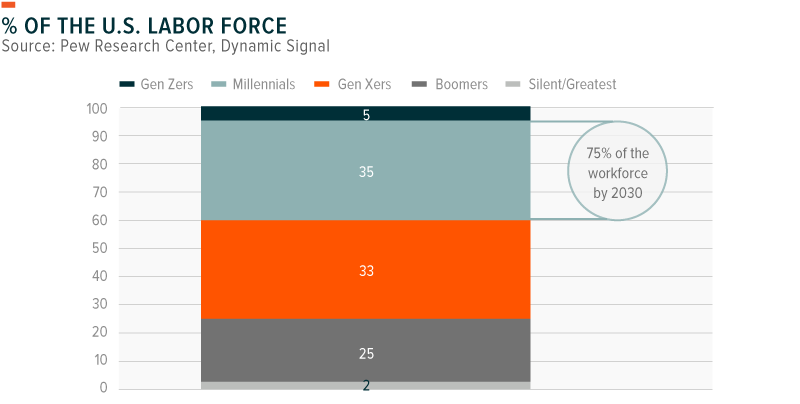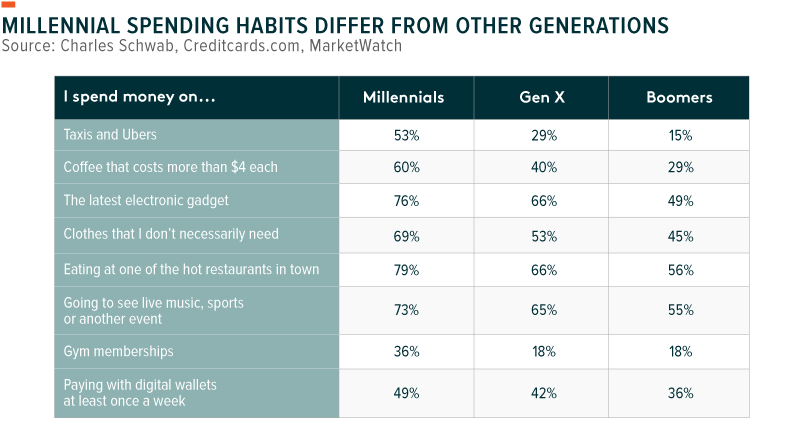While demographic trends are rarely surprising, the enormity of their impact can often be overlooked. For example, over just the last few years, the Millennial generation has evolved, aging from primarily a cohort of cash-strapped students to that of a major share of the US workforce and a powerful consumer group. And like a glacier carving out the side of a mountain, Millennials are slowly, but surely making an indelible mark on the world’s largest economy.
While the media often likes to portray a stereotypical image of Millennials, in this piece we will dive into the facts: who are Millennials really, how have they changed, and how they could impact the US economy.
Who are Millennials?
Millennials, defined as those born roughly between 1980-2000, are about to see the oldest of this age group turn 40, with the youngest closing in on 20 years old. This generation, numbering approximately 90 million, has overtaken the Baby Boomers as not only the largest generation in the US, but also the largest share of the labor force and the most educated. Representing 35% of the labor force today, Millennials are expected to be 75% of US workers by 2030.1 Around 40% have a bachelor’s degree or greater, compared to 29% for Gen Xers and 25% for Baby Boomers, when they were the same age.2 In addition, Millennials are set to inherit an estimated $30 trillion in wealth from the Baby Boomer generation.3 In short, the combination of their size, youth, education, and inheritance set up Millennials to become the driving consumer force for the US economy for many years to come.

How Have They Changed?
Like any generation, Millennials are evolving over time, and while doing so, are shedding many of the stereotypical traits that have been previously attached to this generation. Below are examples of a few shifts that have occurred in just the last three years, corresponding with Millennials largely finishing school, entering the workforce, and even starting families.
Millennials are:
- Finishing up their education: 12% of Millennials plan on taking on new student loan debt, a decline from 21% in 2016 as they largely finish their education.4
- Joining the corporate world: 58% of Millennials in 2018 reported considering starting their own business, down from 62% in 2016.5
- Making money: The median adjusted income in a household headed by a Millennial was $69,000 in 2017 – a higher figure than for nearly every other year on record for people aged 22 to 37.6
- Enjoying disposable income: In 2018, 43% of Millennials reported making a little or a lot more money than needed to cover their expenses, compared to 30% who said the same in 2016.7
- Shopping online: In 2019, an estimated 60% of their purchases are made online, up from 47% two years ago.8
- Moving out: 40% of Millennials now own a house vs. just 26% in 2016. And reversing a common stereotype for the generation, only 16% live with their parents vs. 30% in 2016.9
- Getting married: 38% of Millennials are now married vs. 27% in 2016.10
- Starting families: By 2018, 40% of Millennial women had children.11
- Slowly overcoming the scars of the financial crisis: 9% of Millennials described the state of the US economy as excellent vs. 4% in 2016.12
What Does this Mean for the US Economy?
Millennials are steadily reaching new stages of life that often correspond with higher levels of consumerism: entering the workforce and starting families. This can have a meaningful impact on the economy in two ways: first, Millennials are spending money in certain categories that other generations are not. While Baby Boomers may be dialing back their overall consumption and increasing their spending on health care, for example, Millennials are directing an increasing share of their income towards home ownership, savings, and consumer goods. Second, Millennials have unique consumption preferences from prior generations, such as a particular affinity for leveraging technology, seeking experiences, and prioritizing health and wellness. Our belief is that the firms that operate at the intersection between the major spending categories of where Millennials are spending money and their unique consumption habits and preferences are well-positioned to benefit from this major consumer shift. Conversely, companies that are unable to appeal to Millennial preferences are likely to suffer.

Examples of specific industries that we believe are well-situated to appeal to Millennials include social media, online streaming services, health and wellness, housing and home goods, healthy food and fast-casual restaurants, e-commerce platforms, FinTech, wearables, and travel.
- Social media companies have become increasingly responsible for how Millennials spend their money. In fact, half of Millennials say they are influenced by social media to spend money on experiences.13 As a result, social media companies have offered advertisers what they want the most – data – and have profited heavily from this. For example, Facebook has grown their average revenue per user (ARPU) in the US from about $2 in 2010 to over $30 as of early 2019.14
- The cord-cutting phenomenon is reaching mainstream adoption. In the US, 88% of Millennials have said they subscribe to a streaming service, while 51% said they have a cable subscription.15 Key industry players such as Netflix and Hulu have reached 60 and 27 million paying US subscribers, respectively.16,17
- Living a healthy lifestyle has also been a key part of Millennial spending. Growing awareness of the impact of unhealthy and processed foods on an individual’s health and the environment is changing the way people eat. One-quarter of 25-to-34 years old Americans say they are vegans or vegetarians, causing The Economist to call 2019 to be “The year of the vegan”.18 Plant-based meat-replacements that replicate the taste and feel of beef has a carbon footprint 89% smaller than a burger made from a cow, uses 87% less water, 96% less land, and cuts water contamination by 92%.19 Furthermore, more than half of parents that are organic food consumers are Millennials, a number that is expected to continue to surge over the next years, impacting where they shop, what food they buy, and which restaurants they go to.20
- In the recent years, athleisure has become the option of choice for everyday wear and is now the largest apparel category in the US. Despite the slowdown in the overall apparel market, companies such as Nike and Lululemon continue to ride the wellness wave via comfortable and attractive athleisure wear, a segment that is expected to reach $355 billion in sales by 2021 from $290 billion in 2017.21
- Millennials are making a meaningful impact on the real estate segment as marriage and having children becomes more common for this generation. As a result, home ownership in the US started to pick up in 2016 after more than a decade of decline. Increasing home ownership rates often translate to higher spending as new home owners often repair, refurnish, and remodel. This growth bodes well for companies involved in the sale of home goods, as well as construction and home repair materials.
- The shift to online shopping remains an important trend among Millennials. The US e-commerce industry continues to show strong growth backed not only by faster delivery times that enhances the attractiveness of shopping online, but also by having greater selection of goods, including groceries, that finally started to make its way toward online adoption. For example, aided by Amazon’s integration of Whole Foods, Prime members can now get a free two-hour food delivery in over 80 cities, reducing the friction for online grocery shopping.
- Millennials’ adoption of technology has penetrated their finances. Their mobile devices have become their credit card, their wallet, and their overall bank. Take Venmo, PayPal’s mobile payment service, which is a platform that has struck a chord with Millennials by allowing them to digitally send money and make purchases. 75% of Millennials have used online or mobile payments compared to only 51% for Boomers.22
- Travel is at the top of Millennials’ to-do list. Compared to other generations, Millennials are most likely to spend more on their vacations, with one-third of Millennials willing to spend $5,000 or more.23 This generation is shucking materialism around physical goods and opting for life experiences.
Conclusion
While broad demographic shifts take time, their impact can last for decades and have large implications on broad swaths of the economy. At this moment, we are still in the early innings of the rise of the Millennial consumer, as the generation enters prime working age, forms households, and increases its purchasing power. As this shift intensifies, we believe that it is wise to consider Millennial spending patterns and the companies and industries that are best positioned to capitalize from this secular growth opportunity.
Related ETFs
MILN: The Global X Millennials Thematic ETF seeks to invest in companies that have a high likelihood of benefiting from the rising spending power and unique preferences of the U.S. Millennial generation (birth years ranging from 1980-2000). These companies come from a broad range of categories, including: social media and entertainment, food and dining, clothing and apparel, health and fitness, travel and mobility, education and employment, housing and home goods, and financial services.
Related Themes
Social Media, E-commerce, Health and Wellness, FinTech, Internet of Things
 Pedro Palandrani
Pedro Palandrani